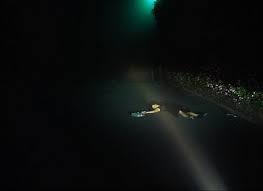| Self-taught photographer Melanie Pullen‘s collection of more than one hundred photographs that comprise High Fashion Crime Scenes is based on vintage creme-scene images she mined from the files of the Los Angeles Police Department, the County Coroner’s Office, and other primary sources. Pullen began this project from the New York City Police Department. Drawn to the rich details and compelling stories preserved in the criminal records, in 2002 she began restaging the events after seeing a copy of Luc Sante’s 1992 book Evidence (1914-1919) about crime scene photos by outfitting the “victims” (her selected models) in current haute couture, and photographing them in her staged settings. She employed the services of up to 80 crew members and models per picture, with each image taking up to a month to create, and the series using over $13 million dollars worth of clothing and accessories. When White Canvas mag interviewed her she talked a little more about this project, saying”: As I grew desensitized to domestic crime and violence, I became more sensitized to images of war. It was a strange phenomenon that I’ve explored and philosophized. I don’t like violence, I have never been a dark person. I see stories and different layers to violent imagery. I’m curious about the response people have to violent images. Melanie Pullen was born in New York City in 1975, and currently lives and works in Los Angeles, California. She is a self-taught photographer who raised in a a family of photojournalists, publishers and artists. Pullen’s work has been exhibited internationally, including solo-shows at Ace Gallery, White Wall Gallery and MiCamera, while she has been profiled in The New York Times, The Los Angeles Times, Beaux Arts, Artweek, Elle, BorderCrossings among others. Pullen’s series High Fashion Crime Scenes, was recently published by Narzareli Press in a 128 page hardcover book which can be found at bookstores worldwide. | SS: Each time before you start shooting one picture, do you really imagine up a whole story leading to her death? Or you just do the shoot and leave the rest to interpretation? Melanie: I always work with the reference material - the original crime scenes that I'm recreating. Those images are normally pretty intense and I've chosen them because they force me to ask so many questions about what happened - they always evoke an emotional response and I want to explore the concept. I believe there needs to be questions and an interaction from the viewer (including myself) to create a good piece of work. I also hold true to that concept when searching for reference materiel. I'm always asking questions and trying to fill in the gaps. I have been most captivated by the images where you don't really see what happened - the evidence shots like the close up images of hands and feet as it just opens up my imagination - I find those very provoking - a few in particular have really stuck with me and I'm still asking questions. SS: With some pictures, they’re tragic, but some there seem to be a lot of humorous elements hidden that make you smile, it’s like watching Alice in Wonderland gone darkly mischievous. What are other moods that you want to convey to the audience behind these characters. Melanie: I tried to create a journey with the work. You notice everything but the crime scene. I'm making fun of the way violence and tragedy are portrayed by the media these days and how over the top it's become. My characters are very innocent and somewhat timeless. I generally play with colour, models, locations and these amazing cloths to really distract the viewer. I always hope that the final result is you leave my one of my exhibitions and wonder why you forgot to look at the crime scene right in front of you. SS: You were inspired to do this from (Luc Sante's book) 'Evidence' and old crime scene photos, but do you also have any muses? Melanie: I love movies! I could name a hundred great movies but I will save you the list. So all of the wonderful directors, cinematographers, actresses and actors are my muses. |
the lighting with in the photos is what attracted me to them. especially the one above i love the darkness but the strip of light illumination the body this is what I had imagined my images to look like something like this with a moody dreamy quality. the issue with this is will it them become more fantasy than a reality for the views I want to keep things as simple as possible when tacking the photos because of the danger of the road side I don't want to put up lights on a buzzy road so i was thinking of car lights because we know that a car or something smiler would have killed the animal.
They are quite dreamy almost playful something I think works well for this project but won't for mine. when reading the articles and interviews there relay is a seance of though put in to placement of the body with research in to the NYPD archive and Luc Sante’s 1992 book Evidence. all the images have a reference from a crime scene some exactly the sima e others have seances pulled from different images.
They are quite dreamy almost playful something I think works well for this project but won't for mine. when reading the articles and interviews there relay is a seance of though put in to placement of the body with research in to the NYPD archive and Luc Sante’s 1992 book Evidence. all the images have a reference from a crime scene some exactly the sima e others have seances pulled from different images.


 RSS Feed
RSS Feed
